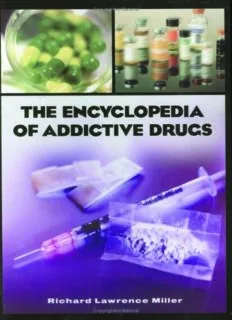
The Encyclopedia of Addictive Drugs PDF
Preview The Encyclopedia of Addictive Drugs
The Encyclopedia of ADDICTIVE DRUGS RICHARD LAWRENCE MILLER GREENWOOD PRESS The Encyclopedia of ADDICTIVE DRUGS The Encyclopedia of ADDICTIVE DRUGS RICHARD LAWRENCE MILLER GREENWOODPRESS Westport,Connecticut • London LibraryofCongressCataloging-in-PublicationData Miller,RichardLawrence. Theencyclopediaofaddictivedrugs/RichardLawrenceMiller. p.cm. Includesbibliographicalreferencesandindex. ISBN0–313–31807–7(alk.paper) 1. Drugsofabuse—Handbooks,manuals,etc. I. Title. RM316.M555 2002 615'.78—dc21 2002075332 BritishLibraryCataloguinginPublicationDataisavailable. Copyright(cid:1)2002byRichardLawrenceMiller Allrightsreserved.Noportionofthisbookmaybe reproduced,byanyprocessortechnique,without theexpresswrittenconsentofthepublisher. LibraryofCongressCatalogCardNumber:2002075332 ISBN:0–313–31807–7 Firstpublishedin2002 GreenwoodPress,88PostRoadWest,Westport,CT06881 AnimprintofGreenwoodPublishingGroup,Inc. www.greenwood.com PrintedintheUnitedStatesofAmerica TM Thepaperusedinthisbookcomplieswiththe PermanentPaperStandardissuedbytheNational InformationStandardsOrganization(Z39.48–1984). 10 9 8 7 6 5 4 3 2 1 Contents Introduction 1 Drug Types 11 Alphabetical Listings of Drugs 31 Sources for More Information 445 Drug Name Index 453 Subject Index 489 Introduction The Encyclopedia of Addictive Drugs will save readers many hours of time that would otherwise be spent tracking down basic facts in science journals and libraries. This book is useful to a wide variety of persons—from a student doing a term paper to reporters preparing a story, from parents reading that story to a narcotics law enforcement officer needing extra information for a public presentation. In writing this book the approach has been multidisciplinary,meaningthat perspectives from several fields of research have been pulled together. The same substance may mean different things to a chemist, a biologist, a physi- cian, or an anthropologist. Thousands of scientific reports were sifted for in- formation and concepts that will be meaningful to readers seeking basic information about specific substances and about drugs in general. The core of this book is an alphabetical listing of substances. Some are not ordinarily thought of as drugs, but all have been misused in ways indistin- guishable from drug abuse. While information in the individual listings and elsewhere may refer to various physical effects, such information does not constitute medical advice. Anyone with a medical difficulty needs to consult a medical practitioner, not this book. In addition to meaty information about what drugs do, this book includes triviathatmightinterest,forexample,astudentpreparingareportorahome- work assignment. For instance, some individual listings of drugs mention little-known military usage that might intrigue teens interested in the armed forces. Some experiments are mentioned not because they are necessary to know about, but because they might add depth to a term paper or inspire a student to pursue a new angle. Material about effects on pregnancy is inher- ently important but might also have special interest for female readers. Inadditiontoalphabeticallistingsofsubstances,thisbookincludesasection aboutdrugtypesinwhichsubstancesarearrangedingeneralcategories,such 2 TheEncyclopediaofAddictiveDrugs as stimulants, with further grouping by classes of stimulants (amphetamine, anorectic, cocaine, pyridine alkaloid). Such an arranging of drugs puts them in a broader context of information. A chemist knows that a certain element has particular characteristics because of its place in the periodic table, and a biologist knows that a certain organism will have particular characteristics because of its species classification. A reader of this book can automatically glean information about an individual substancebecauseofthewayitisclas- sified. For example, everything said in this book about stimulants applies to the class of stimulants known as amphetamines; everything said about am- phetamines applies to the particular drug methamphetamine. (Substances printedinboldhavemainentriesinthisbook’salphabeticalsection.)Areader familiarwithbasicsaboutstimulantsandwhoonlyneedsafewspecificsabout methamphetamine can quickly find those details. A reader who needs to un- derstand more about the general nature of stimulants can find that back- groundinformationaswell.Personsdesiringtogodeeperthanthesummaries of scientific information in alphabetical entries can consult reliable sources listedattheendofeachentry.Manyofthosesourcesliststillmorereferences. This book concludes with a guide to finding general information about drugs. Here readers are directed not only to ostensibly neutral sources of informationbutalsotosourcestakingexplicitanddifferingstancesonvarious aspects of drug use. The index lists street names and other alternate names (used in various communities at various times), giving page numbers where information can be found about those drugs. Descriptions of individual drugs in the alphabetical section of this book present the scientific consensus about those substances, based mainly upon reports from refereed science journals. A refereed journal is onethat doesnot merely accept an author’s word but instead has the articles critiqued and approved by assorted experts prior to publication. Articles in such journals are fundamental sources of scientificinformation.Althoughfindingsreported in this book come from scientific investigations around the world, not every- one agrees with what scientists discover about drugs. Sometimes scientists themselves disagree with one another. The history of science is filled with detection of errors, and future research will no doubt provide new under- standings of these drugs. This book, however, presents scientific consensus concerning these drugs as the twenty-first century begins. DRUGABUSE Drugabuseisanemotionallychargedtopicinvolvingmorethanfactsabout pharmaceuticals. Personal and moral values are involved, as are fears that sometimes transform into anger. The author of this book has studied drug abuse questions since the 1980s; visited with prosecutors, judges, and health care givers, along with drug abusers and their families; drafted drug control legislation introduced by Republican and Democratic legislators; testified be- forelegislativecommittees;andgivenpublicpresentations.Inallsettings,facts have rapidly disappeared in discussion of the topic. For most of the twentieth century, addiction was considered a physical ef-
Description: